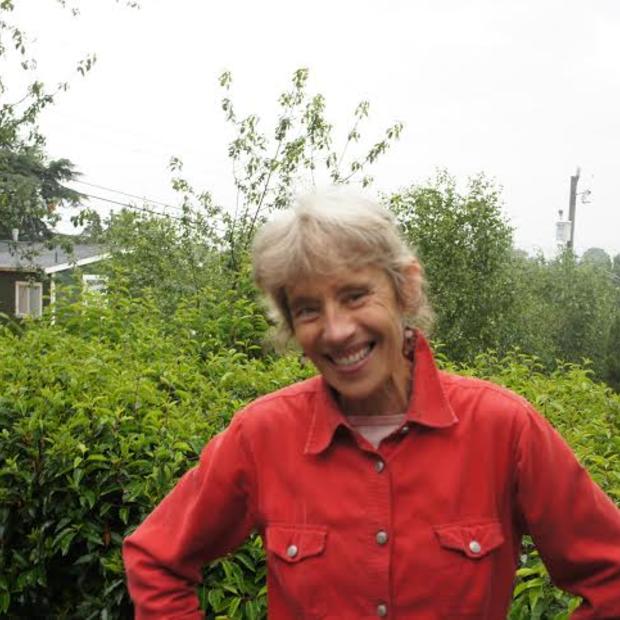In the fertile Snoqualmie Valley, east of Redmond and thirty minutes from downtown Seattle, a winter treat is almost ready for market. Organic farmer Luke Woodward with Oxbow Farm, snaps off a shoot from a crown of open, pollinated broccoli. “It’s the most amazing tasting broccoli you’ll ever eat in your life. You show up at market in March or late February with all this broccoli that’s purple and nobody has anything and people just go crazy,” he says.
It’s been a good year for winter crops at Oxbow, which supplies organic food to restaurants, farmers markets and CSAs. That's not always the case. There were no one-hundred-year floods to contend with this year — a phenomenon that has become common on an annual basis — and no heavy rains followed by a freeze.
Today Oxbow Farm is hosting a tour — not for tourists, but for other farmers. Long a model of ecological farm practices that nourish the land and improve habitat for fish and wildlife, the farm is the perfect backdrop for a clever new farm and forest sustainability program: “Where Cows Meet Clams.”
OK, the cows in this case are grazing at a farm on the other side of the Snoqualmie River and the clams are further downstream in salty waters, but here’s the connection: The young healthy forest growing on the Oxbow Farm side of the river will keep the water cool for salmon and sustainable farm practices will keep the water clean for shellfish and other marine life.
The idea behind “Where Cows Meet Clams” is to tie big picture concepts — the health of Puget Sound water, soil and habitat — with the health of working farms and forests. Funding comes from the EPA’s National Estuary Program and is meant to give farm and forest land owners tools to become more economically secure.
“These farmlands are in some ways our biggest hope,” says Debra Oaks with Stewardship Partners, a non-profit that planted conifers and deciduous trees on the banks of the river. Salmon, she explains, are at just 5 percent of their historical population in the Snoqualmie River. “And this is one of the healthier rivers. It’s real. We don’t have a couple more decades to figure it out. We need to do it now.”
Water-born contamination that runs into rivers — and eventually Puget Sound — from farm land makes it tough for even the hardiest shellfish to survive. It's a problem on two thousand of the state's rivers. Here though, Oxbow Farm uses no excessive fertilizers or pathogens that would run into the Snoqualmie River.
One goal of “Where Cows Meet Clams” is to help farmers understand what stewardship is all about. The dairy farm across the river from Oxbow recently agreed to allow planting on their side of the river, but it took years of exposure to restoration at Oxbow and other valley farms as well as financial support from state agencies and non-profits.
First they’ll get a new well o supply water for the cows, then a fence to keep the cows out of the river. After that, it's on to restoration of tree cover. “A lot of people have it in their mind that if you’re going to plant trees it’s not going to have any kind of impact for ten, twenty or thirty years," Oakes says. "That’s not true. You see a huge difference after one growing season. So give it three years and you have this beautiful lush forest that the birds are coming back to and insects are coming back.”
In a valley hemmed in by development and water, growing healthy food is a high-wire balancing act. “We had four feet of water through the barn on the last big flood,” explains Sarah Cassidy, Oxbow Farm's co-manager. Regulations prohibit building in a flood plain, which can make things hard for struggling farmers, but last year the King County Council made changes to allow “farm pads” or elevated land to protect equipment, produce and livestock.
Josh Monaghan is with the King Conservation District, a partner in the project. "Climatologists predict that the changes we’re going to see in this valley are going to be dramatic," he explains. "If nothing else changes, we’re going to have more dramatic floods in the future.”
Oxbow Farm Education Center already offers camps for children as a means of raising revenue and staying financially sound. But at an on-site workshop after the farm tour, Heidi Siegelbaum with Calyx Sustainable Tourism, throws out ideas to generate more income. Ecotourism, nature based tourism, experiential tourism and anything to do with food. “People are food insane. They are crazy about food and it’s a great way for people to make money and connect people’s culinary interests with your farm.”
Participants take notes. Then they drift back to the fields. There are more questions about planting corn, beans and squash, the mutually beneficial trio Native Americans were famous for. The beans take the low road and branch out around the other two plants, says Oxbow Farm’s Cassidy. They form a living mulch that discourages pests and encourages water and nutrient retention. ”So it’s a beautiful trio of plants that grow together and basically it’s our forest on the farm that kids can just run through and pick at gay abandon.”
There are more questions, but it’s time to go. The Oxbow Farm team has work to do.
For information on farm and forest workshops go to calyxsite.com. Bird sounds from Martyn Stewart with NatureSound.org.



